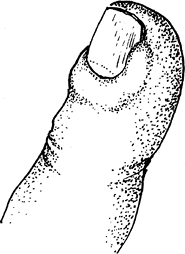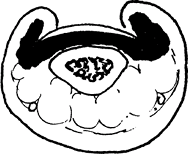Paronychia (Nail Infection)
Editors: Frassica, Frank J.; Sponseller, Paul D.; Wilckens, John H.
Title: 5-Minute Orthopaedic Consult, 2nd Edition
Copyright ©2007 Lippincott Williams & Wilkins
> Table of Contents > Paronychia (Nail Infection)
Paronychia (Nail Infection)
Dawn M. LaPorte MD
Marc Urquhart MD
Description
Paronychia is an infection of the radial or ulnar margins of the nails (lateral fold) of the hand (Fig. 1).
General Prevention
-
Keep the nail clean and appropriately trimmed.
-
Use gloves for work and washing.
-
Avoid nail biting.
Epidemiology
Incidence
-
It is the most common infection in the hand (1–3).
-
Affects all ages
Risk Factors
-
Nail-biting
-
Manicures
-
Diabetes
Etiology
-
Typically secondary to the introduction of Staphylococcus aureus under the nail fold
-
May be related to a hangnail, biting the nail edge, or manicure instrumentation
 Fig. 1. Swelling along the nail. There may or may not be pus coming from the involved area.
Fig. 1. Swelling along the nail. There may or may not be pus coming from the involved area.
Associated Conditions
-
Eponychia:
-
Location: In the periungual tissue at the proximal nail bed (Fig. 2)
-
Treatment (similar to that of paronychia):
-
Incise with a scalpel.
-
Insert small clamp into the abscess and open the inflammatory pocket.
-
Gram stain, culture, and antibiotics.
-
-
-
Felons:
-
Location: Pulp of the finger
-
Treatment:
-
Incise and drain with a lateral incision down to the bone.
-
Spread the tissues with a clamp to disrupt the fibrous septa.
-
Gram stain, culture, and antibiotics
-
-
-
Subungual abscess:
-
Location: Beneath the nail
-
Treatment:
-
Administer an adequate digital block.
-
Remove the nail plate and nail.
-
Obtain a specimen for Gram stain and culture.
-
Irrigate and gently débride any purulent material.
-
Replace the nail and nail fold with nonadherent gauze.
-
1 dose of intravenous antistaphylococcal antibiotics, followed by a 10–14-day course of penicillin or erythromycin.
-
Follow-up as in paronychia is indicated.
![]() Fig. 2. Infection spreading along the nail bed.
Fig. 2. Infection spreading along the nail bed.
-
-
Signs and Symptoms
-
Redness and swelling on the side of the nail fold with pain
-
Possibly becoming fluctuant with discharge
Physical Exam
Examine for infection below the nail plate or in the finger pulp.
Tests
Lab
Lab tests are not needed unless the infection is aggressive and is spreading.
Imaging
Imaging is not necessary unless the nail infection is chronic, aggressive, unresponsive to treatment, or related to trauma.
Pathological Findings
-
Typically, these infections are caused by S. aureus.
-
Changes consistent with acute inflammation are noted.
Differential Diagnosis
-
Eponychia
-
Felons
-
Subungual abscess
-
Tumor or cyst
P.307
General Measures
-
Early diagnosis: If there is erythema without an abscess, then treat with oral antibiotics and warm, soapy soaks.
-
Abscess:
-
If an abscess has formed:
-
Use a digital block with local anesthetic.
-
Immediately drain with a scalpel.
-
Send purulent material for Gram stain and culture.
-
Remove the lateral 1/5 of the nail if necessary.
-
Irrigate the wound copiously with saline solution through an angiocatheter or needle
-
Pack the wound with nonadherent sterile gauze.
-
Initiate a 10–14-day course of empiric
antibiotics: Synthetic penicillin is the drug of choice, or
erythromycin for penicillin-allergic patients because S. aureus is the most common causative organism.
-
-
-
Chronic paronychia:
-
Often occurs in patient populations exposed to water.
-
These patients often have concomitant
fungal infections and should have a topical antifungal ointment or
possibly an oral antifungal agent added to the regimen.
-
-
Medication
First Line
Synthetic penicillins are the drugs of choice.
Surgery
-
Eponychial marsupialization is the most common surgical treatment for chronic paronychia (4,5).
-
Consideration should be given to nail removal, particularly in the presence of a nail deformity.
Prognosis
The prognosis is good, with appropriate care.
Complications
Progressive infection may require more aggressive treatment if it involves the pulp of the finger or extends into the bone.
Patient Monitoring
Reevaluate within 48 hours of initial treatment to ensure that treatment is effective.
References
1. Brown DM, Young VL. Hand infections. South Med J 1993;86:56–66.
2. Canales FL, Newmeyer WL, III, Kilgore ES, Jr. The treatment of felons and paronychias. Hand Clin 1989;5:515–523.
3. Flynn JE. Modern considerations of major hand infections. N Engl J Med 1955;252:605–612.
4. Baran R, Bureau H. Surgical treatment of recalcitrant chronic paronychias of the fingers. J Dermatol Surg Oncol 1981;7:106–107.
5. Bednar MS, Lane LB. Eponychial marsupialization and nail removal for surgical treatment of chronic paronychia. J Hand Surg 1991;16A:314–317.
Additional Reading
Stevanovic MV, Sharpe F. Acute infections in the hand. In: Green DP, Hotchkiss RN, Pederson WC, et al., eds. Green’s Operative Hand Surgery, 5th ed. Philadelphia: Elsevier Churchill Livingstone, 2005:55–93.
Codes
ICD9-CM
-
681.02 Paronychia (finger)
-
681.9 Paronychia with lymphangitis
-
681.9 Subungual abscess
-
757.5 Eponychia
Patient Teaching
Prevention
-
Avoid nail-biting
-
Appropriate care of hang-nails
FAQ
Q: What is the treatment for early presentation of a paronychia?
A:
Early infections can be addressed nonsurgically with oral antibiotics
and soaks 2–3 times daily in warm water and dilute Betadine.
Early infections can be addressed nonsurgically with oral antibiotics
and soaks 2–3 times daily in warm water and dilute Betadine.
Q: Is chronic paronychia treated in the same way as an acute infection?
A:
No. Chronic paronychia is a distinctly different clinical problem and
is best managed with surgery with eponychial marsupialization in
conjunction with oral antibiotics (if cultures are positive) and
possibly antifungal medication.
No. Chronic paronychia is a distinctly different clinical problem and
is best managed with surgery with eponychial marsupialization in
conjunction with oral antibiotics (if cultures are positive) and
possibly antifungal medication.

